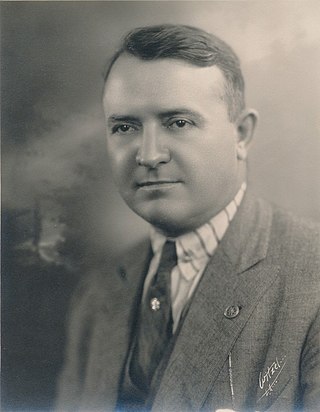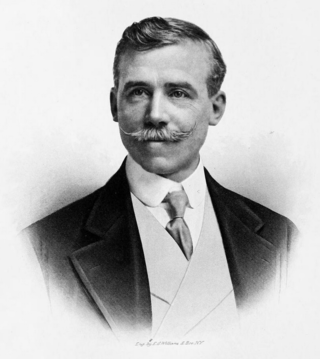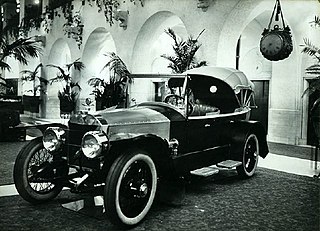
The Winton Motor Carriage Company was a pioneer United States automobile manufacturer based in Cleveland, Ohio. Winton was one of the first American companies to sell a motor car. In 1912, Winton became one of the first American manufacturers of diesel engines.
The Locomobile Company of America was a pioneering American automobile manufacturer founded in 1899, and known for its dedication to precision before the assembly-line era. It was one of the earliest car manufacturers in the advent of the automobile age. For the first two years after its founding, the company was located in Watertown, Massachusetts. Production was transferred to Bridgeport, Connecticut, in 1900, where it remained until the company's demise in 1929. The company manufactured affordable, small steam cars until 1903, when production switched entirely to internal combustion-powered luxury automobiles. Locomobile was taken over in 1922 by Durant Motors and eventually went out of business in 1929. All cars ever produced by the original company were always sold under the brand name Locomobile.
Grand Prix motor racing, a form of motorsport competition, has its roots in organised automobile racing that began in France as early as 1894. It quickly evolved from simple road races from one town to the next, to endurance tests for car and driver. Innovation and the drive of competition soon saw speeds exceeding 100 miles per hour (160 km/h), but because early races took place on open roads, accidents occurred frequently, resulting in deaths both of drivers and of spectators. A common abbreviation used for Grand Prix racing is "GP" or "GP racing".

The American Locomotive Company was an American manufacturer that operated from 1901 to 1969, initially specializing in the production of locomotives but later diversifying and fabricating at various times diesel generators, automobiles, steel, tanks, munitions, oil-production equipment, as well as heat exchangers for nuclear power plants.

Berna Eli "Barney" Oldfield was a pioneer American racing driver. His name was "synonymous with speed in the first two decades of the 20th century". He was the winner of the inaugural AAA National Championship in 1905.

A motorboat, speedboat or powerboat is a boat that is exclusively powered by an engine.

The Acme was a make of American automobiles made in Reading, Pennsylvania from 1903 to 1911. They were the successor of the Reber which was made from 1902 to 1903 by Reber Manufacturing.

Ferenc Szisz, was a Hungarian racing driver and the winner of the first Grand Prix motor racing event on a Renault AK 90CV on 26 June, 1906.

William Kissam Vanderbilt II was an American motor racing enthusiast and yachtsman, and a member of the prominent Vanderbilt family.

The Vanderbilt Cup was the first major trophy in American auto racing.

Royal Motor Car Company was a Brass Era manufacturer of luxury automobiles in Cleveland, Ohio, in business from 1904 to 1911. It was the result of a reorganization of the Hoffman Automobile Company.

The Mercedes Simplex was an automobile produced from 1902 to 1909 by the Daimler Motoren Gesellschaft. It continued the use of the Mercedes name as the brand of DMG, rather than Daimler.

Crane-Simplex was the common name of the Simplex Crane Model 5 luxury automobile, produced by the Simplex Automobile Company in New Brunswick, New Jersey, from 1915 to 1918.

Alexander Winton was a Scottish-American bicycle, automobile, and diesel engine designer and inventor, as well as a businessman and racecar driver. Winton founded the Winton Motor Carriage Company in 1897 in Cleveland, Ohio, making the city an important hub of early automotive manufacturing. His pioneering achievements in the automotive industry included taking one of the first long-distance journeys in America by car and developing one of the first commercial diesel engines. Winton left the automotive manufacturing business when he liquidated his car company in 1924 to focus on his powertrain engineering firm, Winton Gas Engine & Mfg. Co., which he had established twelve years earlier to focus on engine development. This business was sold to General Motors in 1930 and became the Cleveland Diesel Engine Division. Winton died in 1932 and is interred in Lake View Cemetery in Cleveland.

Charles Cleveland Merz was an American racing driver, military officer, engineering entrepreneur, and racing official. Active in the early years of the Indianapolis 500, he later became Chief Steward of the Memorial Day Classic.

Tom Cooper was an American cyclist and early automobile racing driver. He is best known for his rivalry with cyclist Major Taylor, as well as his later work with Henry Ford and Barney Oldfield.

The Fiat S74 was a racing automobile first raced 1903.
Enterprise was a 1930 yacht of the J Class and successful defender of the 1930 America's Cup for the New York Yacht Club. It was ordered by a syndicate headed by Vice-Commodore Winthrop Aldrich, designed by Starling Burgess, and built by Herreshoff Manufacturing Company.

Charles Yale Knight was an entrepreneur and inventor of the sleeve valve technology. His Knight engines would be used in the early cars, British tanks, and British aircraft. Customers included Henry Ford's competitor, John Willys and his company, Willys–Overland Motors, second largest car manufacturer after Ford Motor, as well as by Daimler, Mercedes, Peugeot and others. He was a millionaire by the time he was 44 years of age, in 1912.

The Martin-Wasp or Wasp is a luxury American automobile which was built by the Martin-Wasp Corporation in Bennington, Vermont, from 1919 to 1925.

















